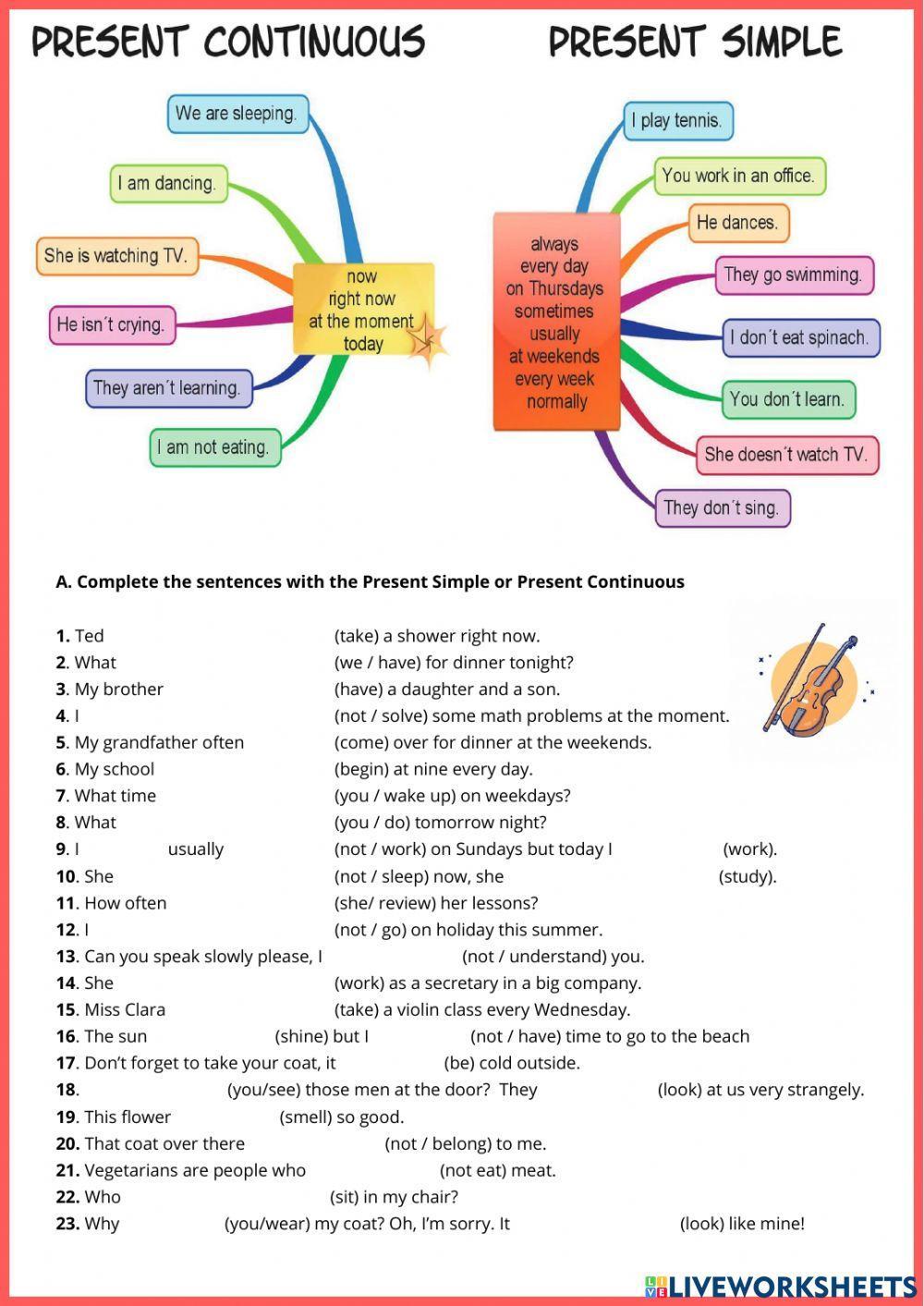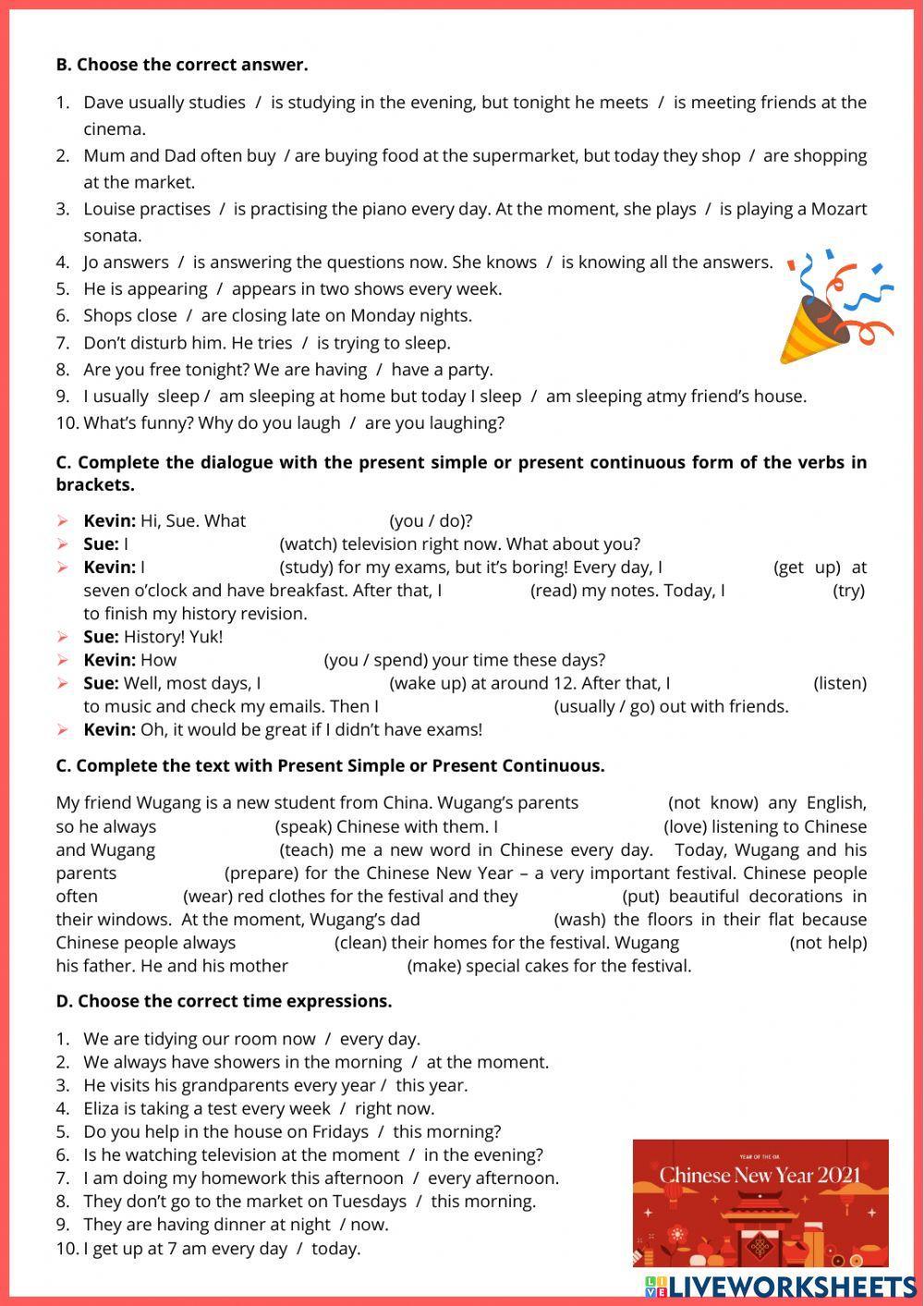Member for
4 years 3 monthsAge: 10-17
Level: A2/B1
Language: English
(en)
ID: 1380240
10/09/2021
Country code: ES
Country: Spain
Main content: Present simple and present continuous (2013176)
From worksheet author:
Present simple vs continuous grammar exercises
Other contents:
grammar
Worksheet description:
Objective Explanation:
The objective of this worksheet is to help students differentiate between the Present Simple and Present Continuous tenses in English language usage. By engaging with various examples and completing sentences with the appropriate tense, students will enhance their understanding of when to use each tense correctly in different contexts.
Content Overview:
The main focus of this worksheet is on the Present Simple and Present Continuous tenses. Students will practice identifying the differences between these two tenses through completing sentences and choosing the correct form of the verb. Key concepts covered include using the Present Simple for habitual actions or general truths, and the Present Continuous for actions happening at the moment or temporary situations.
Language and Educational Level Context:
This worksheet is designed for students learning English as a Second Language (ESL) at a beginner level. The content and exercises are structured to cater to students who are just beginning to grasp the nuances of English grammar. The language used is simple and clear to ensure accessibility for students at this educational level.
Subject Relevance:
Embedded within the field of English as a Second Language (ESL), this worksheet aligns with the broader curriculum by focusing on an essential aspect of English grammar. Understanding the difference between the Present Simple and Present Continuous tenses is crucial for ESL learners as it forms the foundation for expressing actions in the present tense accurately.
Instructions:
The instructions provided in the worksheet guide students on how to differentiate between the Present Simple and Present Continuous tenses effectively. By offering examples such as "We are sleeping" and "I am dancing" for the Present Continuous tense, and "I play tennis" and "You work in an office" for the Present Simple tense, students are encouraged to apply this knowledge to complete sentences accurately. The use of phrases like "at the moment", "usually", and "every day" further reinforces the context in which each tense should be used, aiding students in their comprehension and application of grammar rules.
The objective of this worksheet is to help students differentiate between the Present Simple and Present Continuous tenses in English language usage. By engaging with various examples and completing sentences with the appropriate tense, students will enhance their understanding of when to use each tense correctly in different contexts.
Content Overview:
The main focus of this worksheet is on the Present Simple and Present Continuous tenses. Students will practice identifying the differences between these two tenses through completing sentences and choosing the correct form of the verb. Key concepts covered include using the Present Simple for habitual actions or general truths, and the Present Continuous for actions happening at the moment or temporary situations.
Language and Educational Level Context:
This worksheet is designed for students learning English as a Second Language (ESL) at a beginner level. The content and exercises are structured to cater to students who are just beginning to grasp the nuances of English grammar. The language used is simple and clear to ensure accessibility for students at this educational level.
Subject Relevance:
Embedded within the field of English as a Second Language (ESL), this worksheet aligns with the broader curriculum by focusing on an essential aspect of English grammar. Understanding the difference between the Present Simple and Present Continuous tenses is crucial for ESL learners as it forms the foundation for expressing actions in the present tense accurately.
Instructions:
The instructions provided in the worksheet guide students on how to differentiate between the Present Simple and Present Continuous tenses effectively. By offering examples such as "We are sleeping" and "I am dancing" for the Present Continuous tense, and "I play tennis" and "You work in an office" for the Present Simple tense, students are encouraged to apply this knowledge to complete sentences accurately. The use of phrases like "at the moment", "usually", and "every day" further reinforces the context in which each tense should be used, aiding students in their comprehension and application of grammar rules.
Share / Print Worksheet

